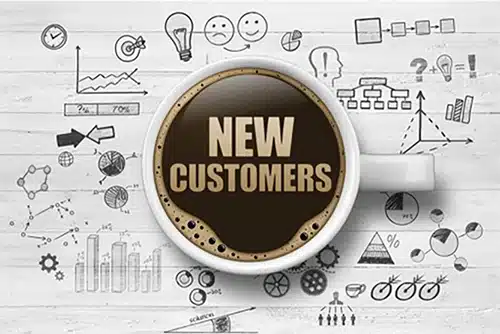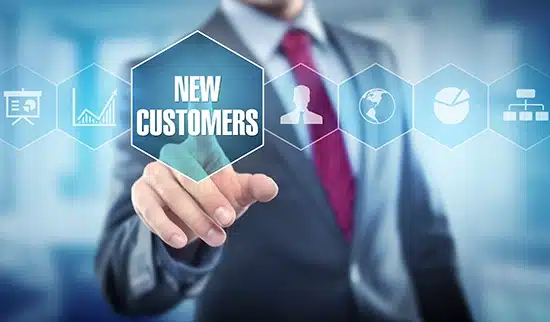MLM Customer Acquisition
Multi-level marketing (MLM) companies rely on attracting new customers to achieve the organization’s growth goals and to ensure compliance with Federal Trade Commission guidelines for direct selling businesses. That makes customer acquisition a central strategy for both MLM companies and their independent sales representatives. But acquiring new customers – and enough of them – can be challenging. Experts estimate that only 5 to 20 percent of potential customers will make a purchase.
To convert more prospects into customers, it helps to understand exactly how a prospective buyer becomes a customer and what you can do to influence their decisions. What follows is a step-by-step guide to help MLM companies and their sales representatives optimize their customer acquisition efforts.

The customer acquisition funnel
Customer acquisition is defined as the process of attracting new customers from a universe of potential buyers. Before becoming a customer, a prospective buyer moves through three defined stages of the buyer journey – awareness, consideration, and then purchase. (Sometimes, these stages are also described as awareness and interest, desire, and action.)
Picture the stages as a funnel, widest at the awareness stage and then narrowing to reflect the smaller numbers of potential customers who progress to the consideration and purchase stages. There are no rules for how – or if – a prospect progresses through the funnel. Some may move through quickly, while others spend a lot of time in the consideration phase.
- Awareness: People can’t make a purchase decision if they don’t even know your company or product exists. Awareness is achieved the moment someone discovers your product or company, and it happens in a variety of ways. Most often, for MLM companies, the introduction occurs through outreach by the MLM field sales representative, whether it’s in-person, online, or via social media. (More on this later.)
- Consideration: When the customer progresses from awareness and interest to consideration, they’re actively seeking additional information to understand your products and services and how they may meet their needs. In other words, they’re weighing their options, but they’re not quite ready to make a purchase.
- Purchase: This is the moment of truth. A prospect has considered the value of your products and services compared to the price and determined that making a purchase is in their best interest. Of course, the customer journey doesn’t end when you’ve converted a prospect into a buyer. Instead, the work begins to turn them from a one-time purchaser into a loyal, repeat customer through the consistent delivery of excellent service, personalized outreach and relationship building, and customer reward programs.
MLM companies and their sales representatives play an important role in influencing a prospect’s progress through the funnel. It all starts with the foundation provided by the MLM company.
The foundation of MLM customer acquisition
MLM companies can help independent sales representatives nurture their prospective customer relationships as they move through the funnel by establishing a solid foundation of valued products and services, strong branding, comprehensive training programs, competitive compensation, and incentives, and robust MLM software platform and rep tools that streamline business processes.
- Valued products and services: MLM companies create differentiation and value for both field representatives and customers by developing products and services that inspire passion and advocacy. The customer value proposition for most direct selling companies is to offer high-quality products combined with the personalized relationships between representatives and their customers.
- Strong branding: Recognizable brands influence customer awareness, consideration, and purchase decisions. For MLM organizations, establishing a strong, consistent brand across in-person, Ecommerce, and product and service experiences is a highly valuable element of successful customer acquisition strategies. Research shows that when a brand is consistently represented across all customer interactions, companies achieve a 33 percent increase in revenue, on average.
- Comprehensive training programs: Investing in product, sales, and service training for sales representatives is vital. But how the training is delivered is absolutely critical. MLM representatives can feel overwhelmed if they’re directed to a vast library of training resources on their first day. Instead, leverage your MLM software to create a thoughtful, journey-based approach to both onboarding and ongoing rep training. The best MLM software platforms enable MLM companies to create bite-sized modules of product, direct selling, and service training and then automate the delivery so that representatives receive the right information at the right time. Journey-based onboarding can automate the delivery of training content triggered by timing, activities, or defined milestones.
- Competitive compensation and incentives: An MLM company’s compensation plan is an essential component of successful customer acquisition. The compensation structure defines how representatives will earn commissions on direct sales as well as bonuses for recruiting new MLM representatives and the subsequent sales activity generated by their downline teams. Through the design of the compensation plan, the MLM company is able to incent and reward specific sales and recruiting behaviors. Rewarding representatives for customer acquisition also helps to ensure FTC compliance, which requires direct selling companies to focus on selling to customers who are not also sales representatives.
- Robust MLM software platform and rep tools: The choice of an MLM software platform is the engine that enables both MLM companies and their representatives to effectively and efficiently run – and grow – the business. Integrated MLM software functionality and tools, such as replicated websites, mobile responsive designs, automated point-of-sale processing, customer relationship management (CRM), and autoship capabilities, streamline core business processes so that representatives stay focused on acquiring customers and recruiting new representatives.

Driving increased customer acquisition
With the foundation in place, MLM organizations and their representatives are ready to drive increased customer acquisition. Specific marketing and selling activities align with each stage of the customer acquisition funnel.
- Awareness-building activities: Every interaction with a potential customer is an opportunity to create awareness. Because the direct selling model is based on establishing relationships between the MLM representative and her customers, awareness is most often initiated by the representative. In the past, MLM representatives had to rely on building a network of customers primarily through referrals and introductions. Today, social media is a powerful way for representatives to target potential customers and expand their reach.
By posting messages and helpful content on social media platforms used by target customers, MLM representatives can create connections and establish themselves as a credible resource and influencer. The key is to focus on being helpful first and selling second. When delivered in a range of formats, including video, social media content can demonstrate an understanding of the target customer’s pain points and challenges and then offer a viable solution. Once a prospective customer is aware of the representative and the solutions being offered, each outreach (whether in-person, via email, or through social media) should include an invitation for the prospect to take an action that moves them into the consideration stage.
- Consideration-building activities: Consideration occurs when the prospective customer seeks to learn more about the MLM brand, products, and services, or the MLM representative. Today, the action is likely to be clicking through to the representative’s replicated Ecommerce website from a social media post or email message. In this scenario, the replicated website serves as an educational resource as well as a platform for browsing, shopping, and purchasing.
Choose MLM software that provides the ability to create integrated replicated websites that make it easy for representatives to create and share a personalized site by adding personal touches, such as their photo or background story. At the same time, the MLM companies deliver a consistent brand experience through a common look and feel, mobile-responsive design, and product positioning.
As prospective customers progress through the consideration stage, they’re often seeking validation that making a purchase would be a good decision. Look for replicated website functionality that enables product reviews and ratings. Customer reviews provide authentic, real-life endorsements for products and services and help potential customers make their buying decisions. The best MLM software should provide the option for the MLM company to review and approve the product reviews before they’re added to the site.
- Purchase-driving activities: As customers consider the value of the products and services, they may need a little push to prompt them to move from consideration to purchasing. This is where the MLM representative’s relationship-building skills and product knowledge can play a starring role.
The direct selling model is ideally suited for representatives to add one-of-a-kind value and insights during all three stages of the customer acquisition funnel. Many MLM products benefit from demonstrations, personalized tips, and real-life examples. Today, representatives can deliver these types of value-adds through one-on-one or party event interactions with prospective customers as well as through virtual, live selling events.
Many MLM representatives opt for free or low-cost platforms like Facebook Live or Zoom to host live selling events. But these options won’t necessarily provide the best customer experiences. Look for MLM software capabilities and tools that effectively link Ecommerce functionality to the online event. Or consider live selling tools that integrate fully with your MLM software and bypass social media platforms. Choosing this type of option means a customer is able to view and interact with a live product demo, click to add the item to her shopping cart, and even complete the purchase transaction – all without having to leave the live selling event.
Your MLM software provider can be a valuable resource as you develop and enhance your customer acquisition strategies. ByDesign Technologies collaborates with MLM companies to help them deliver the tools and capabilities representatives need to build and nurture customer relationships. Visit ByDesign.com to learn more – and contact us to schedule a mlm software consultation.
Contact Us
Learn how the Freedom mlm software can help take your mlm business to the next level.

Additional Articles on MLM Customer Acquisition:
- How do MLM companies acquire customers?
- What software tools do MLM representatives need to succeed?
- How to Find the Right MLM Software at the Right Price

